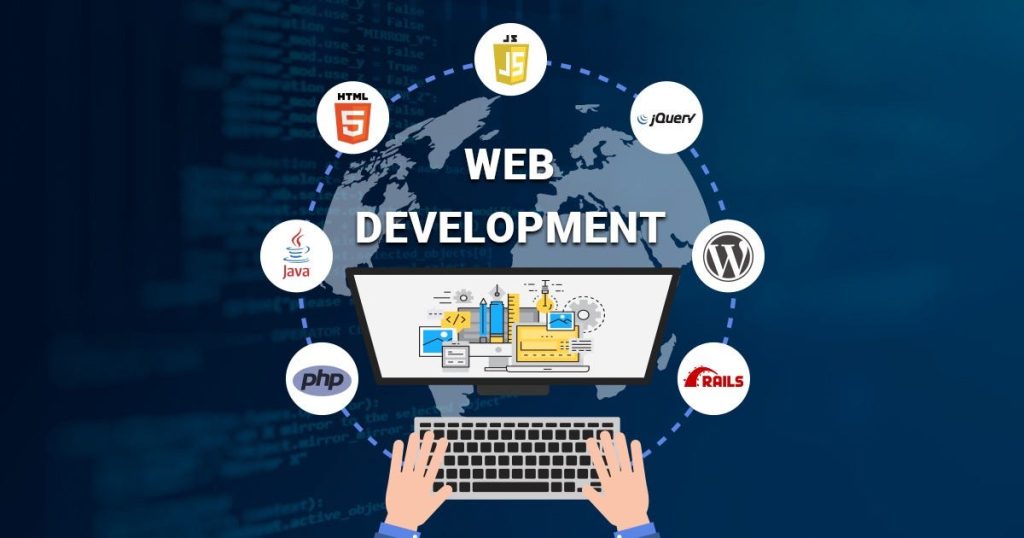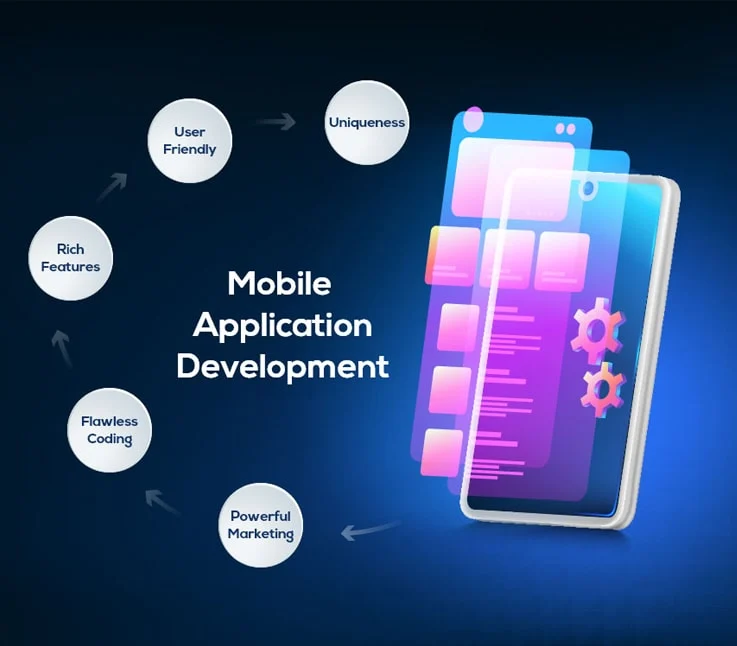
Web Development
Web development is the process of creating websites or web applications using various programming languages, frameworks, and technologies. It involves designing and building the front-end (client-side) and back-end (server-side) components of a website. Front-end development focuses on creating the user interface (UI) and ensuring a seamless user experience (UX). Back-end development deals with server-side programming, database management, and server configuration. Web development encompasses tasks such as coding, testing, optimizing performance, and ensuring compatibility across different browsers and devices. It enables businesses and individuals to establish an online presence, showcase their products or services, and engage with users. Web development plays a critical role in driving digital experiences, e-commerce, and online communication in the modern digital landscape.
App Development
App development is the process of creating software applications for mobile devices, such as smartphones and tablets. It involves designing, coding, testing, and deploying mobile applications across different platforms, such as iOS and Android. App development can range from simple utility apps to complex, feature-rich applications that serve specific purposes or address specific needs. It requires expertise in programming languages, user interface (UI) and user experience (UX) design, and mobile app frameworks. App development plays a crucial role in businesses, allowing them to reach and engage with customers, provide value-added services, and enhance brand visibility. With the growing popularity of mobile devices, app development continues to be an integral part of digital innovation and customer-centric strategies.

![]()
E-Commerce Platform
An e-commerce platform is a software solution that enables businesses to establish and manage online stores. It provides a comprehensive set of tools and features to facilitate product listing, inventory management, secure payment processing, and order fulfillment. E-commerce platforms also include customizable templates, allowing businesses to create visually appealing and user-friendly online storefronts. They support various marketing and sales functionalities, such as promotional campaigns, discounts, and customer reviews. With built-in analytics, businesses can track sales, monitor customer behavior, and gain insights for informed decision-making. E-commerce platforms empower businesses to reach a global customer base, increase sales, and provide a seamless shopping experience for customers in the digital marketplace.
Search Engine Optimization(SEO)
Search Engine Optimization (SEO) is the practice of optimizing a website’s visibility and ranking in search engine results pages (SERPs). It involves implementing various techniques and strategies to improve organic (non-paid) search engine traffic. SEO includes keyword research, on-page optimization, technical optimizations, and off-page factors such as link building and social signals. By optimizing a website for search engines, businesses can increase their online visibility, attract targeted traffic, and enhance their brand presence. Effective SEO can result in higher rankings, increased website traffic, and improved conversion rates. It is an ongoing process that requires monitoring, analysis, and continuous optimization to stay ahead of competitors and meet the ever-changing algorithms of search engines.


Software Solutions
A software solution refers to a comprehensive and customized program or application designed to address specific needs or challenges within an organization. It involves the development, deployment, and maintenance of software to streamline processes, enhance productivity, and achieve desired outcomes. Software solutions can range from simple tools to complex enterprise systems, catering to various industries and functions. They are typically designed to automate tasks, centralize data, improve collaboration, and provide actionable insights. By leveraging software solutions, businesses can optimize their operations, reduce manual efforts, enhance decision-making, and gain a competitive edge. These solutions are constantly evolving to adapt to changing technological landscapes and meet the evolving demands of businesses and users.
Digital Marketing
Digital marketing refers to the use of online channels and technologies to promote products, services, and brands. It encompasses a wide range of strategies, including search engine optimization (SEO), social media marketing, email marketing, content marketing, and pay-per-click advertising. Digital marketing allows businesses to reach a vast audience, target specific demographics, and measure the effectiveness of their campaigns in real-time. It offers greater flexibility, personalization, and cost-effectiveness compared to traditional marketing methods. With the ability to track customer behavior and engagement, businesses can optimize their marketing efforts, improve customer targeting, and drive conversions. Digital marketing has become an essential component of modern marketing strategies, enabling businesses to establish a strong online presence and connect with customers in a dynamic and interactive manner.


Cyber Security
Cybersecurity refers to the practice of protecting computer systems, networks, and digital data from unauthorized access, theft, damage, or disruption. It involves implementing measures to prevent cyber threats, such as malware, phishing attacks, and data breaches. Cybersecurity measures encompass various layers of defense, including robust firewalls, encryption protocols, intrusion detection systems, and regular software updates. Additionally, user education and awareness play a crucial role in maintaining a secure digital environment. Cybersecurity is vital for individuals, businesses, and governments to safeguard sensitive information, maintain privacy, and ensure the integrity of digital assets. As cyber threats continue to evolve, cybersecurity measures must constantly adapt and strengthen to counter emerging risks.
Human Resource Management System(HRM)
A human resource management system (HRMS) is a software solution designed to streamline and automate various HR functions within an organization. It integrates core HR processes such as employee onboarding, attendance tracking, payroll management, performance evaluation, and training administration. The system provides a centralized platform for storing employee data, generating reports, and managing employee benefits. It simplifies HR tasks, improves data accuracy, and enhances employee productivity. With self-service portals, employees can access and update their personal information, apply for leaves, and view payslips, reducing administrative burdens. An HRMS enables organizations to effectively manage their workforce, optimize resource allocation, and align HR strategies with business objectives, ultimately fostering a productive and engaged workforce.


Customer Relationship Management(CRM)
Customer Relationship Management (CRM) refers to a strategy and software system used by businesses to manage and nurture their relationships with customers. A CRM system centralizes customer data, interactions, and preferences, providing a holistic view of each customer’s journey. It enables businesses to track sales opportunities, manage customer communications, and deliver personalized experiences. With features such as contact management, lead tracking, and sales forecasting, CRM enhances customer engagement and sales effectiveness. It also facilitates targeted marketing campaigns, customer support, and analytics to gain valuable insights. By leveraging CRM, organizations can build stronger customer relationships, improve customer satisfaction, and drive long-term loyalty and profitability.